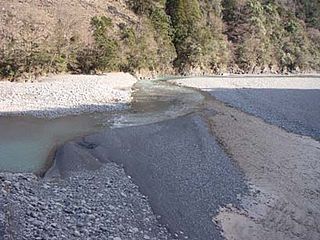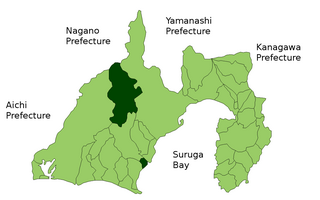
The Tenryū River is a river in central Honshū, Japan. With a length of 213 km (132 mi), it is Japan's ninth longest river.

The Tokuyama Dam is an embankment dam near Ibigawa, Ibi District, Gifu Prefecture in Japan. The dam was completed in 2008 and will support a 153 MW hydroelectric power station that is expected to be fully operational in 2015. Currently, Unit 1 at 23 MW was commissioned in May 2014. The dam was originally intended to withhold the upper reservoir of a 400 MW pumped-storage power station until a design change in 2004. The dam is also intended for flood control and water supply. It is the largest dam by structural volume in Japan and withholds the country's largest reservoir by volume as well.

The Sakuma Dam is a dam on the Tenryū River, located on the border of Toyone, Kitashitara District, Aichi Prefecture on the island of Honshū, Japan. It is one of the tallest dams in Japan and supports a 350 MW hydroelectric power station. Nearby a frequency converter station is installed, allowing interchange of power between Japan's 50 Hz and 60 Hz AC networks.
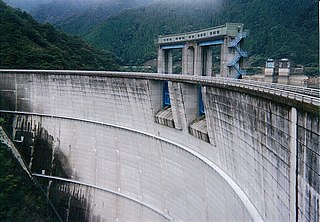
The Shintoyone Dam (新豊根ダム) is a multipurpose dam in the village of Toyone in the Aichi Prefecture of Japan.
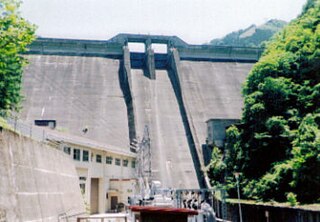
Asahi Dam (朝日ダム) is a dam built on the class 1 Hida River, located in the city of Takayama, Gifu Prefecture, Japan.

The Tashiro Dam is a dam on the Ōi River in Aoi-ku, Shizuoka, Shizuoka Prefecture on the island of Honshū, Japan. It was the first concrete gravity dam to be constructed on the Ōi River, and has a hydroelectric power generating station owned by the Tokyo Electric Power Company.
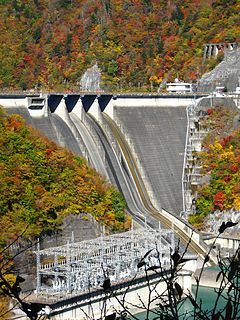
The Hatanagi-I is a dam on the Ōi River in Aoi-ku, Shizuoka, Shizuoka Prefecture on the island of Honshū, Japan. With a height of 125 metres (410 ft), it is the tallest hollow-core concrete gravity dam in the world. It has a hydroelectric power generating station owned by the Chubu Electric Power Company. It supports a 137 megawatts (184,000 hp) pumped-storage hydroelectric power station.

The Hatanagi-II is a dam on the Ōi River in Aoi-ku, Shizuoka, Shizuoka Prefecture on the island of Honshū, Japan. A hollow-core concrete gravity dam, it has a hydroelectric power generating station owned by the Chubu Electric Power Company.

The Ikawa Dam is a dam on the Ōi River in Aoi-ku, Shizuoka, Shizuoka Prefecture on the island of Honshū, Japan. It was the first hollow core concrete gravity dam to be constructed in Japan, and has a hydroelectric power generating station owned by the Chubu Electric Power Company.

The Sasamagawa Dam is a dam on the Sasama River, a tributary of the Ōi River, located on the border of the city of Shimada and the town of Kawanehon, Shizuoka Prefecture on the island of Honshū, Japan.

The Senzu Dam is a dam on the Sumata River, a tributary of the Ōi River, located in Kawanehon Town, Haibara District, Shizuoka Prefecture on the island of Honshū, Japan.

Tenryū-ku (天竜区) is one of the seven wards of the city of Hamamatsu, Shizuoka Prefecture, Japan. It is bordered by Kita-ku and Hamakita-ku in Hamamatsu, the cities of Shimada and Iwata and towns of Mori and Kawanehon in Shizuoka, Shishiro, Tōei and Toyone in Aichi Prefecture and Iida and Tenryū in Nagano Prefecture.

The Nagashima Dam is a dam on the Ōi River, located in Kawanehon Town, Haibara District, Shizuoka Prefecture on the island of Honshū, Japan.
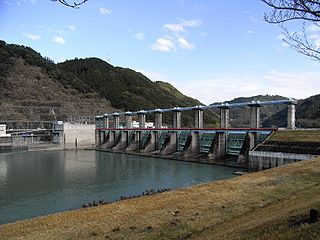
The Funagira Dam is a dam on the Tenryū River, located in Tenryū district, Hamamatsu city, Shizuoka Prefecture on the island of Honshū, Japan.

The Shiogō Dam is a dam on the main stream of the Ōi River, in the town of Kawanehon, Haibara District, Shizuoka Prefecture on the island of Honshū, Japan.
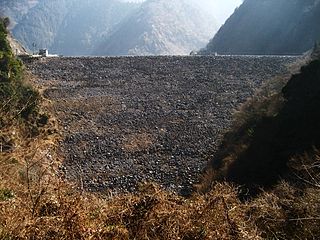
The Misakubo Dam is a dam on the Tonaka River, a tributary stream of the Misakubo River, itself a tributary of the Ōi River, located in Tenyrū-ku Hamamatsu, Shizuoka Prefecture, on the island of Honshū, Japan.
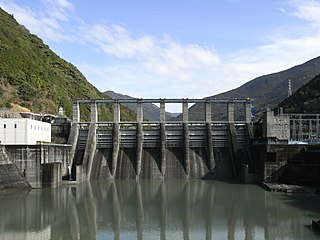
The Akiba Dam is a dam on the Tenryū River, located in Tenryū-ku, Hamamatsu, Shizuoka Prefecture on the island of Honshū, Japan.

Ohashi Dam is a dam built on the Yoshino River in Agawa District, Kōchi Prefecture of Japan. This concrete dam 73.5m high. It is a hydroelectric dam of the Shikoku Electric Power Company. It supplies water to the company's hydroelectric plant, Ohashi Power Station, which can produce up to 5,500kW. It is the lower reservoir for a pumped-storage hydroelectric plant. The upper reservoir being Inamura Dam. Water flowing between these two can produce up to 615MW. It is a public works which The Japan Society of Civil Engineers has recommended as a site of Public Works Heritage.


